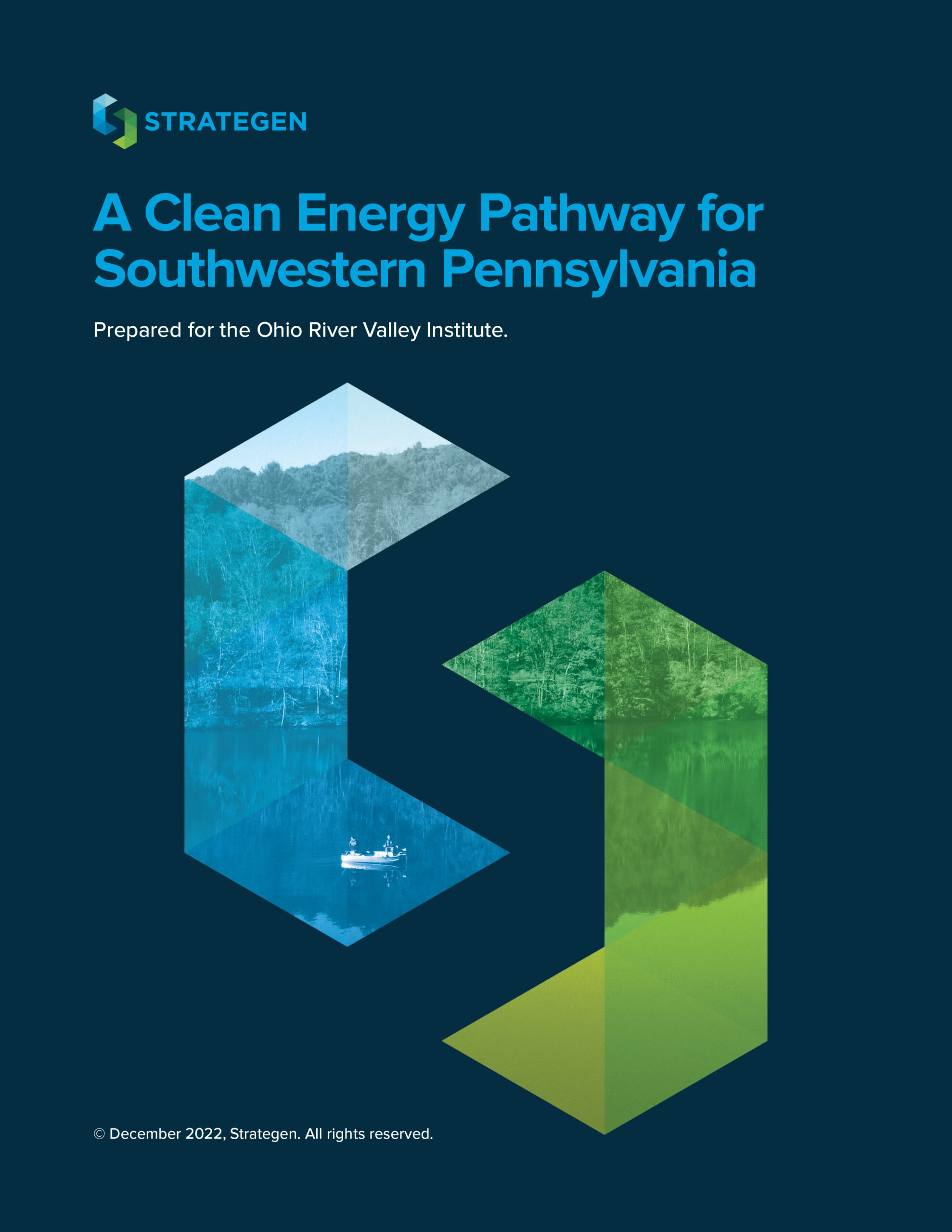This report describes the development and analysis of a clean energy pathway for a 10-county region in southwestern Pennsylvania. Due to its abundance of fossil fuel resources, the region has a long history of substantial energy production, often at the expense of local environmental quality and economic diversity. A transition to clean energy provides a compelling opportunity to transform the local energy profile, while ending the region’s overreliance on fossil fuels, to reduce emissions and pursue a path of sustainable growth.
To date, the prevailing narrative for decarbonizing this region has centered around the perpetuation of the natural gas industry and costly investments in carbon capture and storage (CCS) technologies and infrastructure. Strategen’s analysis provides an alternative focused primarily on zero emissions resources, energy efficiency, increased electrification, and leveraging clean energy imports from outside the region, while minimizing the local need for fossil fuels.
Key Takeaways from this study:
- A renewables-based pathway, including energy efficiency and clean energy imports from the PJM market, is more cost-effective than continued reliance on fossil fuels. A strategy focused on natural gas and carbon capture will be 13% more costly than the clean energy pathway, which avoids expensive investments in CCS technologies to reduce emissions, while limiting the region’s exposure to fuel price volatility and mitigating the risk of stranded fossil fuel assets.
- In the developed decarbonization pathway, all coal plants and a significant portion of natural gas plants in the region will retire or reduce output by 2035, drastically reducing emissions going forward. A limited portion of natural gas plants may be kept online as capacity or peaking resources and to ensure reliability, though clean dispatchable resources could potentially serve this role in the future, as technology progresses.
- The clean energy pathway results in a 97% reduction in CO₂ emissions from the power sector by 2050, leading to environmental benefits of nearly $2.7 billion annually. These benefits are greater than those associated with strategies built around natural gas and CCS, furthering the case for the clean energy pathway as a least cost option for energy transition.
- Deep electrification of the transportation and buildings sectors can directly lower regional CO₂ emissions from these sectors by 95%. The total annual value of environmental and health benefits associated with combined reductions from the power, buildings, and transportation sectors reaches $4.2 billion in 2050, through avoided social costs.
- Through reduced reliance on natural gas for power generation and in buildings, Strategen’s decarbonization pathway will decrease natural gas consumption by 96% and 98%, respectively, for two these sectors by 2050. Lower consumption provides an opportunity to reduce emissions associated with natural gas extraction. The value of these avoided emissions would surpass $1 billion in 2050 alone.
- Energy efficiency is projected to increase over time, reducing regional electricity load by an average of 2.6% each year of the study period. Combined with electrification, the clean energy pathway results in overall load growth of 33% by 2050.
- Efficiency measures not only reduce load, emissions, and the need for additional generation, but also lead to local job creation and savings for consumers. Expenditures on efficiency and resulting residential bill savings support 12,416 total jobs in 2035, and 15,353 total jobs by 2050. Compared to both power generation and fossil fuel extraction, energy efficiency has a greater potential for local economic development, leading to more, higher-paying jobs served by workers and suppliers within the region.
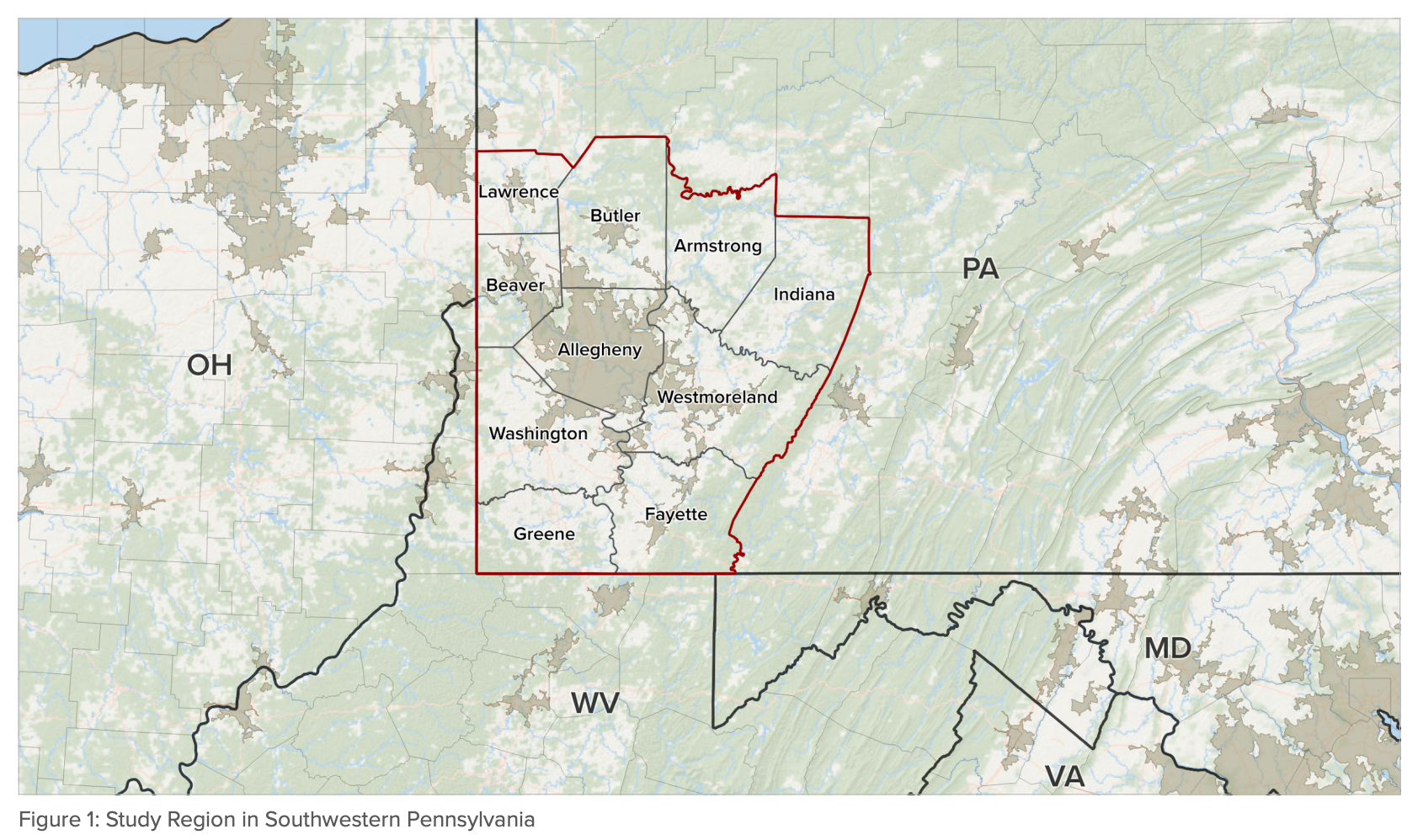
Focusing on the power sector as the backbone of the region’s clean energy transition, Strategen conducted analysis to develop a clean, reliable, and cost-effective resource mix for meeting electricity demand, in a manner more consistent with efforts to limit global warming potential to 1.5° Celsius by 2050. The clean energy analysis additionally included deep electrification to transition nearly all fuel usage from the buildings and transportation sectors to further reduce emissions as the power sector decarbonizes over time. Through the use of an in-house dispatch model, Strategen employed data on localized hourly demand, the potential for renewable energy and energy efficiency improvements, import transmission capacity, and cost forecasts to simulate the operation of the electric grid and determine the necessary resource mix for the region, with limited contributions from fossil generation to ensure reliability.
Strategen’s analysis found that harnessing the local potential for renewable energy in the region and importing clean energy from the PJM interconnection allows for the retirement of all coal resources by 2035 and nearly all natural gas generation by 2050. For balancing and reliability, there is a need for some natural gas or other dispatchable resources to remain on the system, but even these resources have the potential for future decarbonization through possible advancements in technology.
Over time, the region transitions from a net exporter of electricity to a net importer, through the ability to leverage cleaner resources from areas rich in renewable potential via the regional PJM energy market. By 2050, approximately 31% of the energy supply is expected to come from outside of the region. At the same time, electrification, net of increased energy efficiency, results in a 33% growth in load, with the majority met by zero emissions resources, including wind, solar, hydroelectric and nuclear power. Of these resources, solar and wind would experience the largest expansion, increasing demand for land and workers locally and within the PJM region.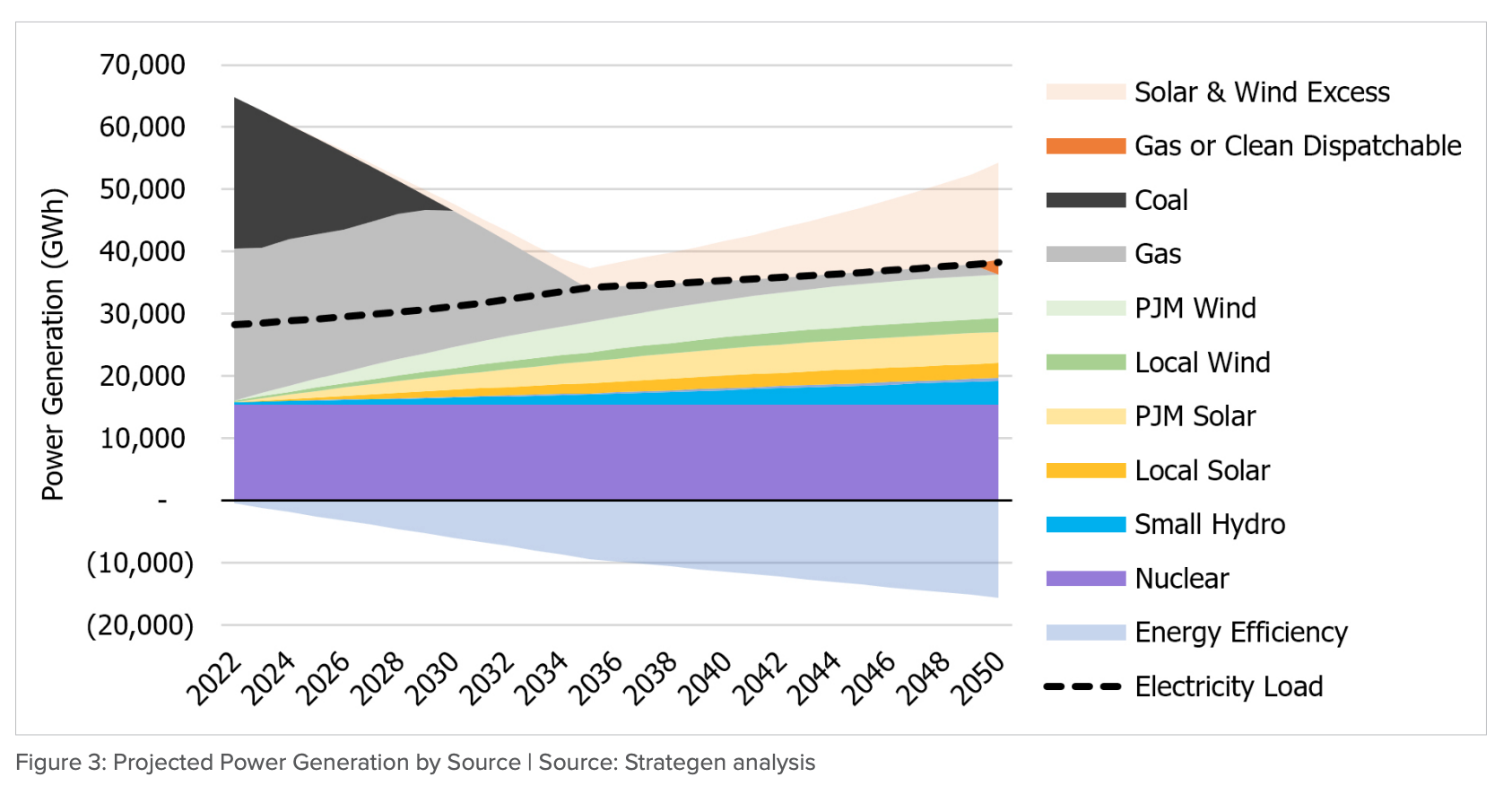
Strategen’s clean energy pathway for the region is actually lower cost than a pathway that relies on natural gas resources with carbon capture. For this comparison, an alternative scenario was developed, assuming that generation must be local to the region and that natural gas resources were not retired, paired with CCS technology instead. Overall, the clean energy pathway for the power sector is 13% less expensive than a pathway relying on gas and CCS.
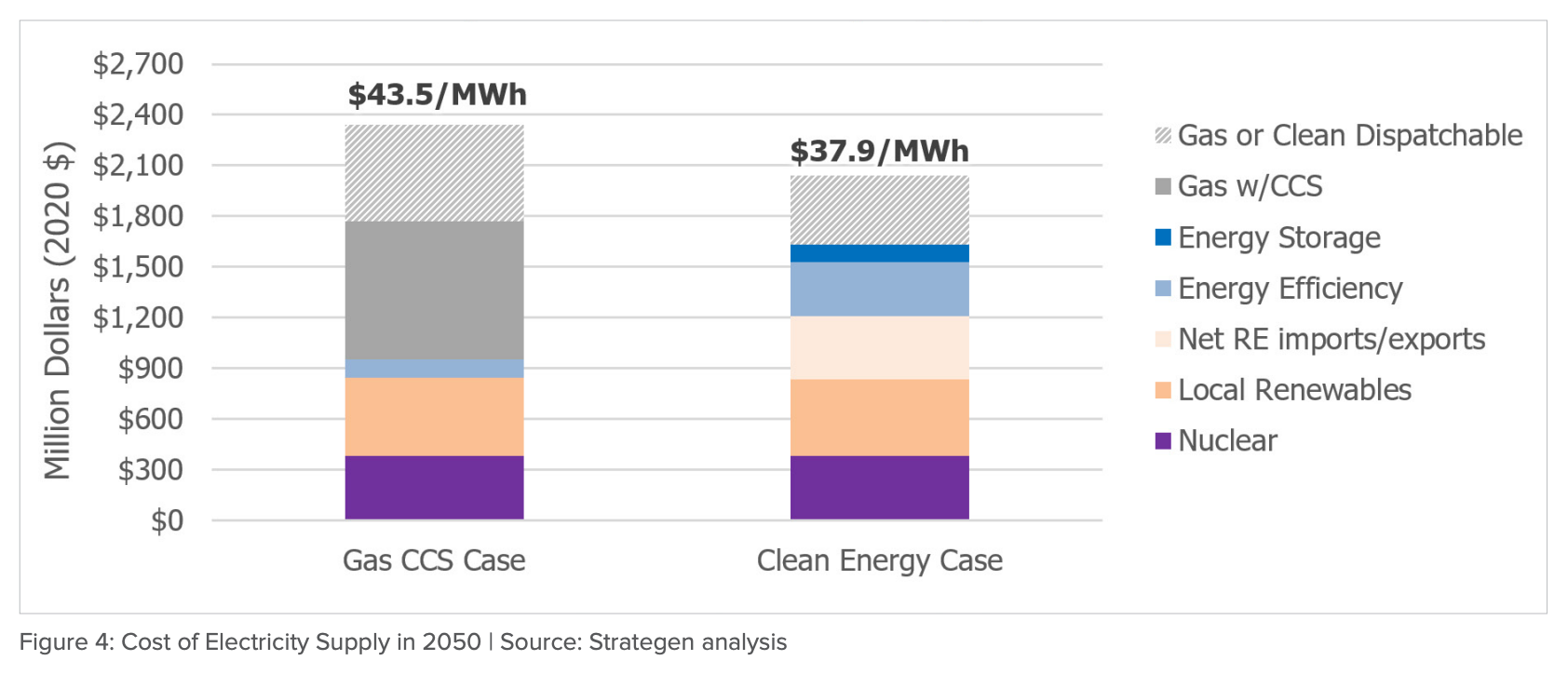 The clean energy pathway reduces emissions drastically, cutting CO₂ emissions by 92% by 2035 and 97% by 2050. The reductions result in environmental and health benefits of more than $2 billion in 2035, reaching $2.7 billion annually by 2050. These environmental benefits are greater than those associated with the alternative case built around natural gas and CCS, further underscoring the finding that a clean energy transition minimizing the use of fossil fuels would be the least cost pathway for southwestern Pennsylvania.
The clean energy pathway reduces emissions drastically, cutting CO₂ emissions by 92% by 2035 and 97% by 2050. The reductions result in environmental and health benefits of more than $2 billion in 2035, reaching $2.7 billion annually by 2050. These environmental benefits are greater than those associated with the alternative case built around natural gas and CCS, further underscoring the finding that a clean energy transition minimizing the use of fossil fuels would be the least cost pathway for southwestern Pennsylvania.
Through electrification, the clean energy pathway additionally reduces CO₂ emissions from the buildings and transportation sectors by 46% in 2035 and 95% by 2050, resulting in annual environmental and health benefits valued at $572 million and $1.5 billion in 2035 and 2050, respectively. In total, reductions in CO₂ from the power, buildings, and transportation sectors lead to annual benefits of $4.2 billion in 2050, through avoided social costs.
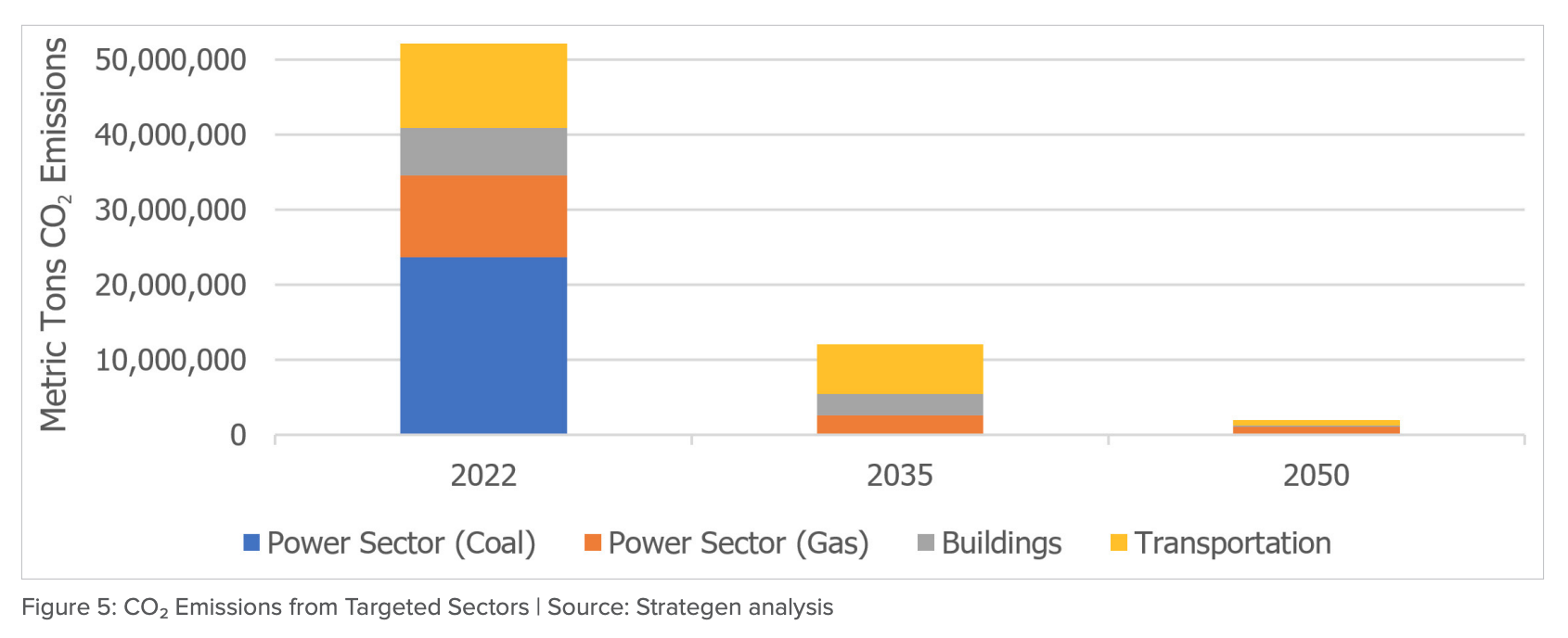
Furthermore, the developed clean energy pathway reduces the region’s reliance on natural gas for power generation and in buildings, resulting in decreases in overall consumption of natural gas from these two sectors of 96% and 98%, respectively, by 2050. This drop in demand, which reaches 500 billion cubic feet annually by the end of the study period, provides the potential opportunity to lower emissions from natural gas extraction. Treated as a corresponding decrease in natural gas production in the region, the value of these avoided emissions and associated damages totals more than $1 billion in 2050.
From an economic development perspective, Strategen’s proposed decarbonization pathway offers further advantages for the local economy. Energy efficiency improvements provide a particularly strong opportunity, as the region transitions away from fossil fuels, generating economic activity in labor-intensive sectors and leading to job creation in industries served by the local workforce. Strategen conducted analysis to explicitly estimate the job creation potential from energy efficiency improvements included in the clean energy pathway for the region, using local multipliers from the U.S. Bureau of Economic Analysis, finding that expenditures on efficiency and resulting residential bill savings support 12,416 total jobs in 2035, and 15,353 total jobs by 2050.

Energy efficiency provides tremendous value not only as a cost-effective alternative to utility scale generation, but also as a compelling driver for local economic development. Compared to electric power generation and fossil fuel extraction, energy efficiency has greater potential for local, sustainable growth. Analysis of multiplier data for the 10-county region shows that efficiency investments create more jobs than these industries, and that the jobs created offer higher wages. Moreover, most efficiency improvements, such as upgrades in lighting, insulation, doors and windows, or heating and cooling systems, can be performed by local workforce, supporting jobs for contractors and suppliers within the region. This is especially true for rural or exurban areas.
In contrast, industries such as natural gas extraction have often relied heavily on workers and suppliers from out of state. Energy efficiency therefore offers a particularly attractive option for a region where job growth and personal income have significantly trailed national growth rates since the beginning of the natural gas boom.
Southwestern Pennsylvania carries a disproportionate socio-economic and environmental burden from the energy industry, but a power sector decarbonization pathway for southwestern Pennsylvania that leverages clean energy imports from the PJM market and is focused on renewable energy, existing nuclear, energy storage, and energy efficiency has the potential to transform the region and shift away from its reliance on fossil fuels. The clean energy pathway designed by Strategen results in cost savings, emissions reductions, and local economic development, laying the groundwork for sustainable prosperity in the 10-county region.

